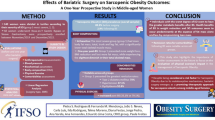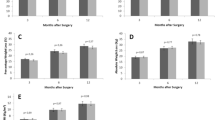Abstract
Background
Sarcopenia pre-dating bariatric surgery (BS) has been suggested as concern for the use of BS in older-adults with morbid obesity.
Objective
To evaluate the impact of age on the prevalence of sarcopenic obesity (SO) in BS-candidates.
Methods
Cross-sectional study including 1370 consecutive BS-candidates aged ≥18, and grouped according to age: 18–39 (reference group), 40–49, 50–59 and ≥ 60 years. From body composition analysis data obtained using bioelectrical impedance, skeletal muscle mass (SMM), SMM index (SMMI=SMM/height2), and percentage of SMM (%SMM = SMM/BW*100) were calculated. Class I or class II SO was adjudicated, respectively, when a value between > − 1 and − 2, or > −2 standard deviations from the regression line from the gender-specific distribution of the relationship between BMI and SMMI or the %SMM in the reference group was encountered.
Results
According to the SMMI distribution, prevalence of class I and class II SO in the whole cohort was respectively 16.4% and 4.6%. SO was more prevalent in females (p < 0.005). Proportion of subjects with SO positively correlated with older age category in females (Tau-c = 0.149, p < 0.001) but not in males. In females aged ≥60, class I SO was present in 29.1%, and class II in 12.8%. Similar results were obtained when %SMM was used (Cohen’s k-coefficient = 0.886, p < 0.001). Age and female gender were identified as independent preditors of SO, whereas CRP or the presence of obesity-associated comorbidities were not.
Conclusion
Age is a risk factor for SO in BS-candidates. SO is fairly common in female subjects aged >60 years that are candidates to BS.
Similar content being viewed by others
References
Peralta M, Ramos M, Lipert A, et al. Prevalence and trends of overweight and obesity in older adults from 10 European countries from 2005 to 2013. Scand J Public Health. 2018;46(5):522–9.
Haywood C, Sumithran P. Treatment of obesity in older persons-a systematic review. Obes Rev. 2019;20(4):588–98.
Mathus-Vliegen EM. Obesity management task force of the European Association for the Study of obesity. Prevalence, pathophysiology, health consequences and treatment options of obesity in the elderly: a guideline. Obes Facts. 2012;5(3):460–83.
Batsis JA, Dolkart KM. Evaluation of older adults with obesity for bariatric surgery: Geriatricians' perspective. J Clin Geront Geriatr. 2015;6(2):45–53.
Cruz-Jentoft AJ, Bahat G, Bauer J, et al. Sarcopenia: revised European consensus on definition and diagnosis. Age Ageing. 2019;48(1):16–31.
Heymsfield SB, Gonzalez MC, Shen W, et al. Weight loss composition is one-fourth fat-free mass: a critical review and critique of this widely cited rule. Obes Rev. 2014;15(4):310–21.
Chaston TB, Dixon JB, O'Brien PE. Changes in fat-free mass during significant weight loss: a systematic review. Int J Obes. 2007;31(5):743–50.
Batsis JA, Villareal DT. Sarcopenic obesity in older adults: aetiology, epidemiology and treatment strategies. Nat Rev Endocrinol. 2018;14(9):513–37.
Giordano S, Victorzon M. Bariatric surgery in elderly patients: a systematic review. Clin Interv Aging. 2015;10:1627–35.
Johnson Stoklossa CA, Sharma AM, Forhan M, et al. Prevalence of Sarcopenic obesity in adults with class II/III obesity using different diagnostic criteria. J Nutr Metab. 2017;2017:7307618.
Mastino D, Robert M, Betry C, et al. Bariatric surgery outcomes in Sarcopenic obesity. Obes Surg. 2016;26(10):2355–62.
Johnson Stoklossa CA, Ghosh SS, Forhan M, et al. Poor physical function as a marker of sarcopenia in adults with class II/III obesity. Curr Dev Nutr. 2017;2(3):nzx008.
Voican CS, Lebrun A, Maitre S, et al. Predictive score of sarcopenia occurrence one year after bariatric surgery in severely obese patients. PLoS One. 2018;13(5):e0197248.
Gaillard M, Tranchart H, Maitre S, et al. Preoperative detection of Sarcopenic obesity helps to predict the occurrence of gastric leak after sleeve gastrectomy. Obes Surg. 2018;28(8):2379–85.
Careaga M, Moizé V, Flores L, et al. Inflammation and iron status in bariatric surgery candidates. Surg Obes Relat Dis. 2015;11(4):906–11.
Janssen I, Heymsfield SB, Baumgartner RN, et al. Estimation of skeletal muscle mass by bioelectrical impedance. J Appl Physiol (1985). 2000;89(2):465–71.
Baumgartner RN, Wayne SJ, Waters DL, et al. Sarcopenic obesity predicts instrumental activities of daily living disabilitiy in the elderly. Obes Res. 2004;12(12):1995–2004.
Schautz B, Later W, Heller M, et al. Total and regional relationship between lean and fat mass with increasing adiposity-impact for the diagnosis of sarcopenic obesity. Eur J Clin Nutr. 2012;66(12):1356–6.
Prado CM, Lieffers JR, McCargar LJ, et al. Prevalence and clinical implications of sarcopenic obesity in patients with solid tumours of the respiratory and gastrointestinal tracts: a population-based study. Lancet Oncol. 2008;9(7):629–35.
Baumgartner RN. Body composition in healthy aging. Ann N Y Acad Sci. 2000;904:437–48.
Bouchard DR, Dionne IJ, Brochu M. Sarcopenic obesity and physical capacity in older men and women: data from the nutrition as a determinant of succesful aging (NuAge)-the Quebec longitudinal study. Obesity (Silver Spring). 2009;17(11):2082–8.
Batsis JA, Mackenzie TA, Emeny RT, et al. Low lean mass with and without obesity, and mortality: results from the 1999-2004 National Health and nutrition examination survey. J Gerontol A Biol Sci Med Sci. 2017;72(10):1445–51.
Levine ME, Crimmins EM. The impact of insulin resistance and inflammation on the association between sarcopenic obesity and physical functioning. Obesity (Silver Spring). 2012;20(10):2101–6.
Bastien M, Poirier P, Lemieux I, et al. Overview of epidemiology and contribution of obesity to cardiovascular disease. Prog Cardiovasc Dis. 2014;56(4):369–81.
Kim TN, Choi KM. The implications of sarcopenia and sarcopenic obesity on cardiometabolic disease. J Cell Biochem. 2015;116(7):1171–8.
Poggiogalle E, Lubrano C, Gnessi L, et al. The decline in muscle strength and muscle quality in relation to metabolic derangements in adult women with obesity. Clin Nutr. 2019;5614:30062–7.
Otto M, Kautt S, Kremer M, et al. Handgrip strength as a predictor for post bariatric body composition. Obes Surg. 2014;24(12):2082–8.
Hamer M, O'Donovan G. Sarcopenic obesity, weight loss, and mortality: the English longitudinal study of ageing. Am J Clin Nutr. 2017;106(1):125–9.
Newman AB, Kupelian V, Visser M, et al. Sarcopenia: alternative definitions and associations with lower extremity function. J Am Geriatr Soc. 2003;51(11):1602–9.
Acknowledgments
This work was supported by a grant from the Fondo de Investigaciones Sanitarias (PI17/00215), Instituto de Salud Carlos III (Madrid, Spain), and European Funds for Regional Development (FEDER) from the European Union.
Funding
This work was supported by a grant from the Fondo de Investigaciones Sanitarias (PI17/00215), Instituto de Salud Carlos III (Madrid, Spain), and European Funds for Regional Development (FEDER) from the European Union.
Author information
Authors and Affiliations
Corresponding author
Ethics declarations
Conflict of Interest
The authors of this manuscript have no personal or financial conflicts of interest to declare.
Statement of Authorship and Ethics
The individual contribution of the authors to this manuscript was as follows: (1) the conception and design of the study, or acquisition of data, or analysis and interpretation of data: JM, LF, JV; (2) drafting the article or revising it critically for important intellectual content: JM, LF, VM, AA, AdH, AJ, JV; (3) final approval of the version to be submitted: JM, LF, VM, AA, AdH, AJ, JV. We alse declare the present work complies with all requirements from the Committee on Publication Ethics.
Additional information
Publisher’s Note
Springer Nature remains neutral with regard to jurisdictional claims in published maps and institutional affiliations.
Electronic supplementary material
ESM 1
Distribution of relationship between SMMI and BMI [panels A (males) and B (females)] and SMM% and BMI [panels C (males) and D (females)] in the study cohort. The regression line and the lines corresponding to + or -1 or + or – 2 standard deviations from the regression line in the reference group (age 18-39 y) are shown. SMMI: skeletal muscle mass index, %SMM: percent skeletal muscle mass, BMI: body mass index. (PPTX 204 kb)
Rights and permissions
About this article
Cite this article
Molero, J., Moizé, V., Flores, L. et al. The Impact of Age on the Prevalence of Sarcopenic Obesity in Bariatric Surgery Candidates. OBES SURG 30, 2158–2164 (2020). https://doi.org/10.1007/s11695-019-04198-4
Published:
Issue Date:
DOI: https://doi.org/10.1007/s11695-019-04198-4




